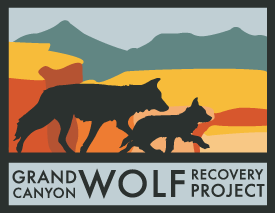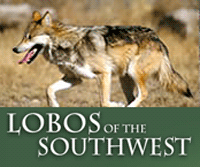The Arizona Republic (Original) Posted on November 15, 2014 Opinion Article by Ed Montini
I picture him loping south through the forest on the Kaibab Plateau, a chill wind pushing through the ponderosa pines and blue spruce, as if whispering to the other animals — elk, deer, squirrels, even mountain lions — that an ancient presence has returned.
There are roads through the forest but he does not follow them. He stays in the shadows where the ground is cold and hard.
He keeps moving, alert, determined, until the trees thin out, the sky opens up and the land seems to disappear in front of him. He stops at the edge of a great chasm, the North Rim of the Grand Canyon.
It is not wise of him to be out in the open. There are buildings nearby. Solid, rough-hewn structures of stone and logs, but large and well kept, something he's unfamiliar with. Humans visit here, although only when the weather is warm.
But how could he not come out into the open with that view?
That's how the lone wolf was spotted.
In the past few months, several people have reported seeing him.
Or is it her?
The experts don't know for sure. But they are fairly convinced that the animal observed at the North Rim is a gray wolf. If so, it probably made the long journey to Arizona from the Rocky Mountains. Imagine that.
There used to be gray wolves living at the Canyon.
They disappeared because of human hysteria, a powerful livestock lobby and a government-approved hunting program that wiped out the population in the contiguous 48 states by the 1950s.
Now, hopefully, one of them is back.
"There have been continued reports about this wolf being up there," said Kim Crumbo of the Grand Canyon Wildlands Council. "The Fish and Wildlife Service and the Park Service are keeping tabs on it. We just want to make sure it is protected. It's been wandering around there for about a month. It's definitely not a Mexican wolf. It's more than likely a northern Rockies wolf. It has a radio collar on its neck that looks like the ones they use up north but it's not operational so they're having a hard time figuring out where it is."
A wolf is wise to be wary.
Sandy Bahr of the Arizona Sierra Club told me, "We have put up so many barriers with these animals. But in spite of all we do they manage to persist. And one of the cool things about Arizona is we still have enough public land to support animals like that. I hope this wolf stays deep in the park on the North Rim. There aren't many people in that part of the park. That's a good thing for a wolf, to be in a place where there aren't many people."
Park workers and volunteers are searching the area of the North Rim for signs of the wolf. If they were to find some of its scat, for instance, they could test it and definitively identify the breed.
In a press release, Michael Robinson, a wolf advocate with the Center for Biological Diversity, said, "This wolf's journey starkly highlights the fact that wolf recovery is still in its infancy and that these important and magnificent animals continue to need Endangered Species Act protections."
It's silly and vain for us to ascribe human attributes, human emotions, to a wolf.
Still, I can't help but picture him (or her) on the edge of the Grand Canyon, howling with delight.
Imagine the echo.





